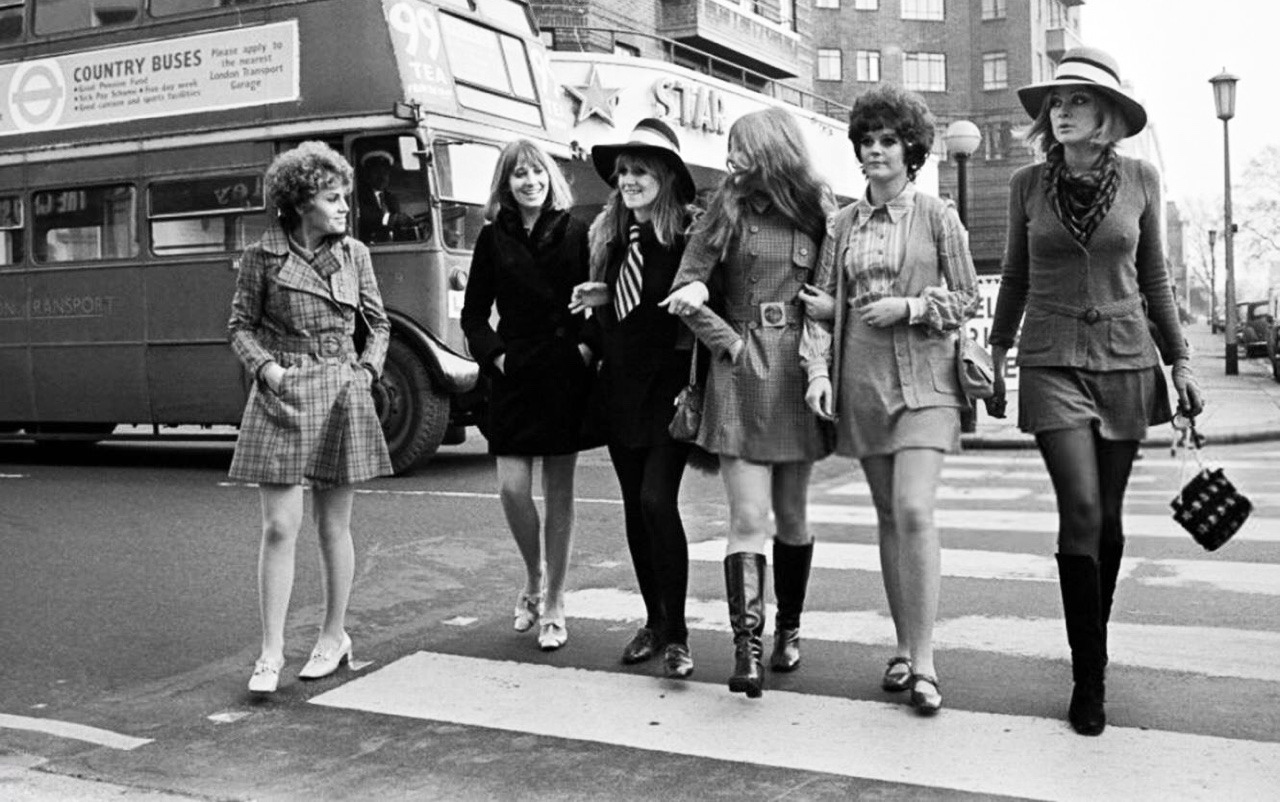The miniskirt has become a garment that every woman and girl today owns in her wardrobe. But what is the origin of this item of clothing, and what meaning has it carried?
The need to shorten skirts arose mainly for practical reasons, long before the invention of the miniskirt in 1963. At the beginning of the twentieth century, working women were already wearing trousers—then considered primarily men’s clothing—in order to enjoy greater freedom of movement in factories. In the 1920s, skirts began to shorten, reaching just below the knee thanks to Coco Chanel’s intuition. However, they were slow to spread into everyday use, partly due to World War II. Still, between the 1920s and 1940s, especially in the entertainment world, female figures—pin-ups and sex symbols—were often depicted in revealing and very short clothing.
It wasn’t until the 1960s, however, that the miniskirt was widely worn by women. Its invention is attributed to British designer Mary Quant, who had already begun designing shorter dresses in the 1950s. At first, miniskirts weren’t very short—just 5 cm above the knee—but over time, they became progressively shorter. This shift was driven by women themselves, who increasingly demanded shorter garments as a sign of newfound freedom: the freedom to reveal their bodies and rebel against social conventions. Young women of the 1960s wanted to prove that life could be lived differently. They wanted to break away from the social norms of the 1950s “economic boom,” which had confined their mothers to the role of the so-called “happy housewife,” trapped at home as perfect wives, mothers, and consumers. The rebellious spirit of the 1960s found expression in fashion, breaking the tradition of below-the-knee skirts that symbolized women’s social oppression. This rupture with an oppressive past allowed women to rediscover their bodies and reimagine femininity. The miniskirt also became a symbol of sexual liberation, in contrast to the repression endured by their mothers.
Showing their legs—which until then had been considered scandalous and vulgar—gaining freedom of movement, and claiming a new sexuality marked a true victory for women’s emancipation. Women could finally present themselves as new subjects within the revolutionary society of the 1960s, no longer as objects. The story of the miniskirt was, at its core, written by women themselves—driven by their needs and their demand for freedom.
Yet the miniskirt was also met with criticism, especially from some Western states that even attempted to ban it, claiming it was too short and could expose women to risks such as sexual violence. Mary Quant’s reflection on this is striking: “In European nations where miniskirts are banned on the streets, saying they are an invitation to rape, they fail to understand the purpose of stockings.” For women, the miniskirt had become a way to assert self-determination and write their own story in a world that refused to place them at the center.
While at first it symbolized emancipation, freedom, and independence, later some feminists began to criticize its overuse as a deliberate form of provocation, tied to the “woman-as-object” stereotype. Starting in the 1970s, advertisements increasingly showed models in miniskirts or very short dresses, drawing attention to women’s bodies rather than the products being sold. Similarly, the cultural industry (film, television) exploited the popularity of the miniskirt to reinforce the sex-symbol myth, with figures such as Marilyn Monroe, Brigitte Bardot, and Sophia Loren becoming icons of female beauty and sensuality—once again reducing women to “objects.”
Over time, the miniskirt lost the rebellious, combative meaning it had carried for the young women of the 1960s—the desire to break with the past and imagine a freer future.
Why did I want to tell the story of the miniskirt?
Because fashion can be—and is—a form of expression, both personal and collective, and I believe it is important for us women in 2024 to reflect on why there is an increasing trend, whether we call it fashion or necessity, toward “undressing.” This raises questions about what it means for today’s girls to feel the need to “show” their bodies, much like it did in the history of the miniskirt.
Now that warmer weather is (finally) arriving, I often see girls wearing shorter and shorter clothes. Yet this isn’t just a seasonal trend—it has become the norm year-round: girls dress less and reveal more of their bodies. I admit I’m not a shopping enthusiast, but whenever I go to the mall, I notice that women’s clothing—especially in fast-fashion stores—keeps shrinking and shortening, which suggests that fashion itself is trying to tell us something. Is this a sign of emancipation? I doubt it, since our grandmothers and great-grandmothers already fought that battle. In a way, we inherited the results. And yet, as I said before, clothing is a form of expression. So I ask myself: what is an adolescent or young woman trying to communicate when she walks around with her stomach bare, or in shorts and skirts barely covering her hips?
I believe awareness plays a fundamental role. I strongly doubt that most girls—especially teenagers—dress this way consciously. For them, it may simply be easier to follow fashion without asking why. Adolescents are at a stage of life when they are still coming to terms with their bodies, often feeling insecure. It is, I believe, the most important stage in which to build a genuine relationship with one’s body. Constantly seeing other people’s bodies can heighten insecurity and make it harder to get to know oneself physically, since they are always comparing—and perhaps even competing—with others. Through clothing, the relationship with one’s body changes, as it is constantly exposed to the outside world, to others, even strangers. Awareness begins with recognizing that we are, first and foremost, a body—one that can be seen, touched, and perceived.
Exposing one’s body in such an excessive and unconscious way, in my opinion, can weaken the sense of intimacy. Intimacy is not only about trust and closeness, but also about inner life. Our relationship with our body is, in some way, intimate—and very few people should have access to that intimacy, not just physically. Deciding what to reveal of ourselves to others should not, I think, be dictated by fashion, but rather by a personal process of growth, which allows each person to consciously decide how much of themselves to share.
At the same time, this awareness carries its flip side: the beauty of self-expression, of feeling free, of showing oneself, of feeling good in one’s own skin, of feeling beautiful and sensual. The beauty and courage of revealing who we are to others, going beyond judgment, and building confidence with our own intimacy, before stepping out into the world and creating new relationships.
If we once again think back to the story of the miniskirt, the women of that era knew exactly what they wanted to express through that garment: showing their bodies as a means of gaining greater freedom. And we — which direction do we want to take?


Leave a Reply to Lezioni dal passato: la minigonna – ECOLOGIA DIGITALECancel reply